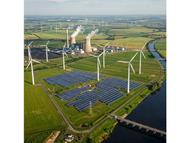From: The Heartland Institue
By: James Taylor, H. Sterling Burnett, Linnea Lueken
Date: November, 2024
Utilities Are Going All-In on Leftist Net-Zero Agenda at Ratepayers’ Expense
EXECUTIVE SUMMARY
Big utilities have hired a massive army of lobbyists to champion expensive and unreliable wind power, solar power, and an aggressive net-zero carbon dioxide agenda at the expense of affordable, reliable, and abundant conventional energy sources. They are trying to convince conservative lawmakers that they are friends of ratepayers and the environment, but both claims are false. Nor are they for “all of the above” energy; in fact, they are for eliminating coal and natural gas from America’s power mix.
American Electric Power, Salt River Project, Duke Energy, Dominion Energy, and American Electric Power are among the big utilities pushing this agenda, which undermines U.S. energy and economic security, a stable electric grid, and affordable electric power. In their own words:
American Electric Power, Salt River Project, Duke Energy, Dominion Energy, and American Electric Power are among the big utilities pushing this agenda, which undermines U.S. energy and economic security, a stable electric grid, and affordable electric power.
American Electric Power champions the Biden administration’s radical net-zero proposal in its Climate Impact Analysis. AEP asserts, “For the nation to achieve its economy-wide clean energy objectives by 2050 or sooner, as called for in the Biden administration’s climate plan, the transformation of the electric sector is vital.”
Salt River Project’s 2023 Sustainability report states the utility plans to “reduce the amount of CO2 emitted by generation (per MWh) by 82% from 2005 levels by 2035” and reach netzero by 2050. The report also champions the elimination of coal and natural gas power by committing to “transforming Arizona’s energy future by decarbonizing our generation sources at an accelerated rate.”
Lynn Good, CEO of Duke Energy, bragged at a 2022 shareholder meeting, “We’ve taken aggressive action, expanding our net-zero emissions goal to … target energy from coal to represent less than 5% of our total generation by 2030, and a full exit by 2035 … [and replacing them with] renewables and battery storage ….”
Dominion Energy fully supports government bureaucrats imposing forced changes in energy markets, as evidenced by Dominion’s CEO Robert Blue in a press interview: “Sometimes the government needs to focus on outcomes. We’re trying to address a climate crisis and we are going to need to move quickly in order to do that.” Blue said Dominion would be “all for” a federal policy that “achieves the outcomes” of a government-directed transition to wind and solar power.
American Electric Power (AEP) chairman Nicholas Akins brags, “AEP has retired or sold nearly 13,500 megawatts (MW) of coal-fueled generation during the past decade, and by 2030, we will have reduced our coal-fueled generating capacity by 74% from 2010 levels. This is significant progress.”
Electricity demand is growing, and is expected to continue to grow, especially with the boom in computing data centers and server farms for technologies like artificial intelligence and quantum computing. Likewise, the Energy Information Administration says the push for electric vehicles will drive electricity rates up further. Despite this, utilities are undertaking electric power supply plans that will make supply less reliable as demand increases.
The plans also come with significant requests for rate increases and special charges, despite the utilities claiming that the renewable sources they are adopting are cheaper than traditional power sources.
To prevent accelerating rate increases and shore up grid reliability, we suggest requiring utilities to make the prime focus of their efforts reliability and affordability. To do this, states should:
Enact laws specifying that electric power reliability and affordability are the highest priorities in utilities plans and rate cases, while rescinding climate policies and mandates and subsidies for renewable power development, which necessarily comes at the expense of reliability and affordability.
Prevent utilities from closing baseload power plants unless and until equally reliable baseload sources are brought online for replacement. Wind and solar don’t meet these requirements.
Establish a position of ratepayer advocate on state utility regulatory commissions, whose charge would be dedicated solely to ensuring utility plans brought before the commission minimize the cost of monopoly utilities’ new construction and rate plans, while reinforcing reliability.
Require that sources of electric power be labeled for transparency reasons to account for their full panoply of environmental and economic impacts — which allows an applesto-apples comparison of proposed and existing energy sources.
Establish the security of the electric power grid and supply by requiring states’ electric power be produced from technologies and fuels sourced domestically within the United States to minimize reliance on foreign nations for critical materials.
Provide security for people dependent on electricity for their daily lives. Going forward utility commissions should only sanction electric power sources that can provide power on demand, readily available 24/7. (continue reading)
Utilities Are Going All-In on Leftist Net-Zero Agenda at Ratepayers’ Expense
 The Right Insight is looking for writers who are qualified in our content areas. Learn More...
The Right Insight is looking for writers who are qualified in our content areas. Learn More...










